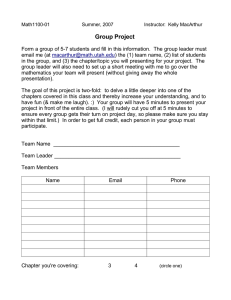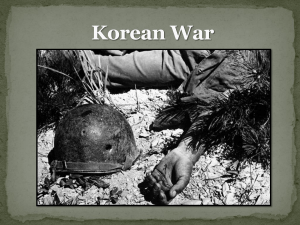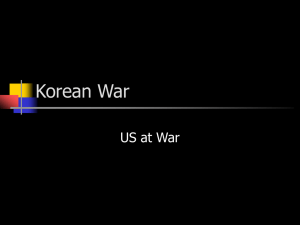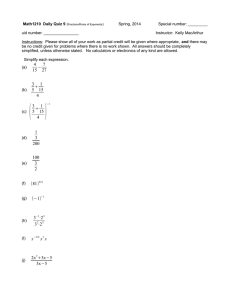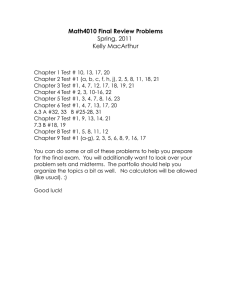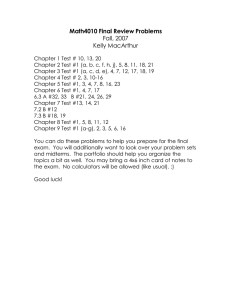THE VISIONARY: MACARTHUR AT INCHON Chapter Six
advertisement
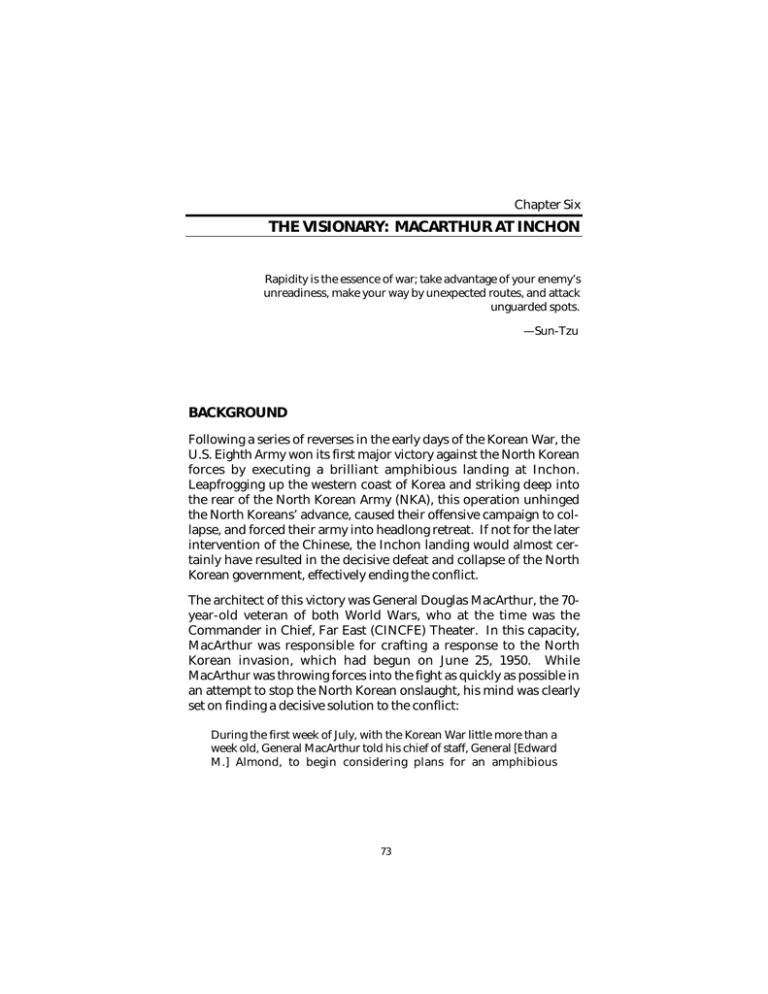
Chapter Six THE VISIONARY: MACARTHUR AT INCHON Rapidity is the essence of war; take advantage of your enemy’s unreadiness, make your way by unexpected routes, and attack unguarded spots. —Sun-Tzu BACKGROUND Following a series of reverses in the early days of the Korean War, the U.S. Eighth Army won its first major victory against the North Korean forces by executing a brilliant amphibious landing at Inchon. Leapfrogging up the western coast of Korea and striking deep into the rear of the North Korean Army (NKA), this operation unhinged the North Koreans’ advance, caused their offensive campaign to collapse, and forced their army into headlong retreat. If not for the later intervention of the Chinese, the Inchon landing would almost certainly have resulted in the decisive defeat and collapse of the North Korean government, effectively ending the conflict. The architect of this victory was General Douglas MacArthur, the 70year-old veteran of both World Wars, who at the time was the Commander in Chief, Far East (CINCFE) Theater. In this capacity, MacArthur was responsible for crafting a response to the North Korean invasion, which had begun on June 25, 1950. While MacArthur was throwing forces into the fight as quickly as possible in an attempt to stop the North Korean onslaught, his mind was clearly set on finding a decisive solution to the conflict: During the first week of July, with the Korean War little more than a week old, General MacArthur told his chief of staff, General [Edward M.] Almond, to begin considering plans for an amphibious 73 74 Command Concepts operation designed to strike the enemy center of communications at Seoul, and to study the location for a landing to accomplish this.1 By late July, the plan had taken shape: On 23 July, General [Edwin K.] Wright [MacArthur’s G-3] upon MacArthur’s instructions circulated to the GHQ [General Headquarters] staff sections the outline of Operation CHROMITE. CHROMITE called for an amphibious operation in September and postulated three plans: (1) Plan 100-B, landing at Inchon on the west coast; (2) Plan 100-C, landing at Kunsan on the west coast; (3) Plan 100-D, landing near Chumunjin-up on the east coast. Plan 100-B, calling for a landing at Inchon with a simultaneous attack by the Eighth Army, was favored.2 On August 12, MacArthur issued CINCFE Operation Plan 100-B and specifically named the Inchon-Seoul area as the target that a special invasion force would seize by amphibious assault. MacArthur began planning and preparation with a planning cell located in his own GHQ staff; forces earmarked for the operation were to be placed in GHQ Reserve as they became available. On August 26, MacArthur requested and received authorization to activate a Corps Headquarters, X Corps, as the operational unit to execute the mission. On the same day, he appointed his Chief of Staff, Major General Almond, to command the corps.3 The major ground units of X Corps were to be the 1st Marine Division, commanded by Major General Oliver P. Smith, and the 7th Infantry Division, commanded by Major General David G. Barr. The 1st Marines were in the United States, and had to be swiftly outfitted and transported to the theater of operations. General Smith was given three weeks to get his division (less one regiment) ready, and at the last moment was given an additional replacement regi______________ 1 Roy E. Appleman, South to the Naktong, North to the Yalu, Washington, D.C.: Center for Military History, 1961, p. 488. 2 Appleman, 1961, p. 489. 3 Appleman, 1961, p. 490. The Visionary: MacArthur at Inchon 75 ment composed of recruits and a battalion of Marines extracted from duty in the Mediterranean.4 The 7th Infantry Division, stationed in Japan at the time, was also undermanned, being at about half-strength. Its ranks had been thinned over the preceding two months to provide trained replacements for the 24th and 2nd Infantry Divisions in Korea.5 As a stopgap measure, over 8,000 Korean recruits were sent to Japan to augment the 7th Infantry Division.6 Integrating, acclimating, and training these replacements was begun in a desperate hurry. While MacArthur never wavered in his commitment to the Inchon plan, circumstances forced a series of postponements. Since the beginning of the war on June 25, the North Korean Army had forced the combined Republic of Korea (ROK)/U.S. forces to withdraw nearly 150 miles south—from positions near the Han River to defensive positions on the southern tip of the Korean peninsula, known collectively as the “Pusan Perimeter” (see Figure 6.1). Stopping this advance had absorbed every soldier, sailor, and airman that MacArthur could get his hands on. During the waning days of August 1950, the North Korean High Command also had problems—exploiting this success was proving difficult. With most of its forces deep in South Korea, North Korea’s primitive supply system was overstrained. Especially troublesome was the inability of the North Korean Army to feed and clothe its soldiers. By September 1, many units were having trouble feeding their troops more than one meal per day. 7 With winter not far away, time was growing short for the North Koreans to finish the fight. In response to this urgency, the North Korean High Command planned a massive offensive for early September aimed at placing pressure on all sides of the Pusan Perimeter. For this effort, the ______________ 4 Appleman, 1961, p. 491. 5 On July 27, the 7th Infantry Division was 9,117 men under strength (Appleman, 1961, p. 491). 6 Appleman, 1961, p. 492. 7 Appleman, 1961, pp. 393–394. 76 Command Concepts RANDMR775-6.1 CHINA Scale 0 NORTH KOREA Ch'uch'on Seoul SOUTH KOREA Inch'on Wonju Ullung-do Suuon Yellow Sea NKA Kunsan Taegu Sea of Japan Yong san Kongjyu 8th Army Pusan Mokp'o Yosu Chin-do 150 km Koje-do Korea Strait Tsushima Cheju-do Figure 6.1—The Pusan Perimeter 300 The Visionary: MacArthur at Inchon 77 North Koreans assembled 13 infantry divisions and 2 armored divisions, with a total strength of nearly 98,000 men. 8 This force attacked on September 1, immediately placing the integrity of the Pusan Perimeter in peril. By September 3, General Walton H. Walker, the Eighth Army commander, had crises in at least five places around the perimeter.9 After several desperate battles at Kongjyu in the east, Taegu in the center, and Yongsan in the north, the combined Eighth Army/ROK forces managed to hold, and by September 11, those crises had passed. 10 Two weeks of the heaviest fighting of the war had produced inconclusive results. However, with most of the enemy’s combat power piled up near Pusan, MacArthur clearly saw that his opportunity had come, despite the fact that the Eighth Army remained in dire peril. The frustrating wait was over. Before he could launch his invasion, however, MacArthur had other battles to fight. The enemy was not the only obstacle to the execution of his plan. The selection of the landing site was a subject of great controversy within the U.S. military. MacArthur had a clear vision of the importance of Inchon as a landing site, but the practicalities of battling the difficult tidal conditions there caused the Navy and Marine Corps to raise strong objections. The issue had come to a head at a conference in Japan on July 23 attended by General J. Lawton Collins, the Army Chief of Staff, Admiral Forrest P. Sherman, the Chief of Naval Operations, and General MacArthur: He [MacArthur] talked as though delivering a soliloquy for forty-five minutes, dwelling in a conversational tone on the reasons why the landing should be made at Inchon. He said that the enemy had neglected his rear and was dangling on a thin logistical rope that could be quickly cut in the Seoul area, that the enemy had committed practically all of his forces against the Eighth Army in the south and had no trained reserves and little power of recuperation.11 ______________ 8 Appleman, 1961, pp. 394–395. 9 Appleman, 1961, p. 397. 10Appleman, 1961, p. 487. 11Appleman, 1961, p. 493. 78 Command Concepts In his arguments, MacArthur focused on the reasons for making such a landing and the conditions under which a landing would achieve the objectives of cutting the supply lines of the NKA, destroying the NKA (see Figure 6.2): MacArthur stressed the strategic, political, and psychological reasons for the landing at Inchon and the quick capture of Seoul, the capital of South Korea. . . . General MacArthur then turned to a consideration of a landing at Kunsan, 100 miles below Inchon, which General Collins and Admiral Sherman favored. MacArthur said the idea was good but the location wrong. He did not think a landing there would result in severing the North Korean supply lines and destroying the North Korean Army. He returned to his emphasis in Inchon, saying that the amphibious landing was tactically the most powerful device available to the United Nations Command and that to employ it properly meant to strike deep and hard into enemy territory.12 Collins and Sherman returned to Washington with the understanding that the landing site was still an open question. MacArthur, however, was unswerving in his preparations for Inchon alone. For the next month, despite instructions from Washington to prepare plans for an alternative site as well as for Inchon, MacArthur proceeded with his original intention and issued his United Nations Command operations order for the landing on August 30. It was at this time that the North Korean Army initiated its massive assault on the Pusan Perimeter. The Eighth Army commander voiced doubts about whether the perimeter could hold, to say nothing of conducting an offensive breakout in support of the landings to the north. MacArthur insisted that the opportunity was there, that it would be strategically foolish to reinforce the Pusan Perimeter, and on September 6 issued an instruction to all his major commanders setting the landing date for September 15. Because of his insistence and his powers of persuasion with the Joint Chiefs, MacArthur received authorization on September 9 to proceed with the landing at Inchon—despite the fact that the encircled UN forces at Pusan were hanging on by a slender thread. ______________ 12Appleman, 1961, p. 493. The Visionary: MacArthur at Inchon 79 RANDMR775-6.2 CHINA Scale 0 NORTH KOREA Ch'uch'on Seoul R HU RT CA A M 150 km 300 SOUTH KOREA Inch'on Wonju Ullung-do Suuon NKA Yellow Sea Kunsan Taegu Sea of Japan Yong san Kongjyu INS LL CO 8th Army Pusan Mokp'o Chin-do Yosu Koje-do Korea Strait Tsushima Cheju-do Figure 6.2—Competing Command Concepts for the Relief of the Pusan Perimeter 80 Command Concepts THE PLANS It is revealing of MacArthur’s vision that he considered the Inchon operation to be an Army mission. Although the Navy and Marine Corps were essential to the success of the operation, MacArthur understood that the real task—the destruction of the North Korean Army—would have to be accomplished by the Eighth Army’s “hammer” slamming the NKA against the X Corps’ “anvil” 30 km inland from the beach. Additionally, intelligence estimates predicted little or no resistance to the landing operation, and only small numbers of NKA forces available to oppose the recapture of Seoul. For this reason, while the amphibious operation required an enormous amount of preparation and planning under a severe time constraint, and a high degree of technical competence to execute, MacArthur seemed to consider it a low-risk exercise. Despite grumbling from the Navy and the Marines, MacArthur activated an Army headquarters and placed his own deputy in command. The Army focus of the operation was evident from the top down: [MacArthur] would require a Headquarters for a lightning-like strike which could be handled by the personnel then available to the Far East Command [with] many able, experienced, and senior officers who had commanded in Europe and in Italy. Once a force had been landed the principal problem would be a land operation over some 18 miles of terrain involving a river crossing. . . . The real essence of the Inchon landing was not merely to land and form a beachhead but to drive across difficult terrain 18 miles and capture a large city and thereafter properly outpost and protect that city.13 The complexity of the landing operation is reflected in the command relationships shown in Figure 6.3. MacArthur placed Admiral Arthur D. Struble (Commander, 7th Fleet) in overall command of the amphibious operation. Struble task-organized his assets. Each of the resulting six task forces (TFs) has its own function. It is worth noting that the sole function of five of the task forces was to work together to get the sixth, TF 92/X Corps, ashore and on its feet. For ______________ 13 Robert D. Heinl, Victory at High Tide, Philadelphia: J. B. Lippincott, 1968, p. 54 (emphasis added). The Visionary: MacArthur at Inchon 81 RANDMR775-6.3 CINCFE CINCUNC MacArthur Eighth Army Walker COMFEAF Stratemyer COMNAVFE Joy CJTF-7 Struble PATROL & RECON TF 99 Henderson COVERING FORCE TF 91 Andrewes (RN) X CORPS TF 92 Almond ATTACK FORCE TF 90 Doyle FAST CARRIERS TF 77 Ewen 7th ID Barr 1st Mar Div Smith Trans Group TACAIR X Corps (MAG -33) Advance Attack Group Sears Gunfire Spt Group LOGISTICS SUPPORT TF 79 Austin Higgins X Corps Troops NOTE: CINCFE = Commander in Chief of the Far East Command; CINCUNC = Commander in Chief of the United Nations Command; CJTF-7 = Commander, Joint Task Force, 7th Fleet; COMFEAF = Commander of the Far East Command Air Force; COMNAVFE = Commander of the Navy of the Far East Command; ID = Intelligence Division; MAG = Marine Air Group; TACAIR = Tactical Air. Figure 6.3—Operation CHROMITE Command Relationships this purpose, the 1st Marine Division was detailed from X Corps to Admiral James Doyle’s attack force (TF 90) until such time as there were sufficient forces ashore to activate X Corps command functions. The landings themselves had to be made in the face of extraordinary conditions in the Inchon harbor, where tides of 31 feet were not uncommon. Hydrographic studies showed that, on invasion day, there would be a short morning and afternoon window at high tide during 82 Command Concepts which there would be enough water in the harbor to support the LSTs (Landing Ships, Tank), critical to rapid projection of combat power inland. Therefore the decision was made to conduct the landing in two phases. Moreover, the landing had to occur on September 15: The extreme high tide on that day—the only such day in September—would put the maximum high tide over Inchon’s mud flats at 31.2 feet. Twelve days later, on the 27th, there would be only 27 feet (two feet short of what the LSTs needed). Not until October 11 would there again be 30 feet of water.14 The first phase was to be an early-morning assault by a Marine Battalion Landing Team (BLT) to secure the island of Wolmi-do, which guarded the approaches to the harbor. Then there would be a hiatus of several hours before the tides would permit the landing of the main force. THE BATTLE On September 10 and 11, the flotilla departed for Inchon, the 1st Marines sailing from Kobe and the 7th Infantry Division from Yokohama, Japan. Despite the interference caused by two typhoons, the entire force managed to get under way on time. On September 13 and 14, the Gunfire Support Group, commanded by Rear Admiral J. M. Higgins, conducted a preliminary bombardment in conjunction with aircraft from Task Force 77 to knock out the shore defenses around the landing sites. Having succeeded in their task, they retired to support positions. The X Corps landing force arrived off Inchon on September 15, with a total strength of over 70,000 combatants. The assault force debarked into their landing craft, crossed the line of departure at 0625, and headed for the landing beaches on the first objective, the harbor island of Wolmi-do, approximately 1 mile away:15 ______________ 14Heinl, 1968, p. 33. 15Appleman, 1961, p. 505. The Visionary: MacArthur at Inchon 83 The first troops ashore moved rapidly inland against almost no resistance. Within a few minutes the second wave landed. Then came the LSV’s carrying the tanks . . . the reduction of the island proceeded systematically and was secured at 0750.16 The landing team on Wolmi-do settled in and prepared to support the main landing across the harbor. At 1530, the tide was sufficiently high to begin launching the landing craft for the main assault. The first wave, led by the 5th Marine Regiment, breasted the seawall in Inchon harbor at 1730. Despite several sharp encounters with North Korean defenders, the landing force secured its D-Day objectives by 0130, September 16.17 Early on the morning of September 16, the two Marine regiments ashore effected a linkup, sealing off the approaches to Inchon and enabling the landing of a regiment of ROK Marines, who conducted mop-up operations in the city. By the evening of September 16, the situation had sufficiently developed for General Smith, the 1st Marine Division Commander, to move his headquarters ashore and notify the Assault Force Commander, Admiral Doyle, that he was assuming responsibility for operations ashore.18 By September 17, the Marines had moved inland and captured Kimpo Airfield, approximately 8 miles west of Seoul. On September 19, Marine aircraft were conducting flight operations from Kimpo, completing the landing objectives, and setting the stage for the capture of Seoul. At the same time, the 7th Infantry Division had landed and had assumed blocking positions to the south of the Seoul highway. Despite difficult tidal conditions and the small size of the harbor, by the evening of September 18, the Navy had unloaded 25,606 persons, 4,547 vehicles, and 14,166 tons of cargo. MacArthur’s concept was proven valid, the landing achieved strategic surprise, and the stage ______________ 16Appleman, 1961, p. 506. 17Appleman, 1961, p. 507. 18Appleman, 1961, p. 509. 84 Command Concepts was set for the liberation of Seoul and the destruction of the North Korean Army.19 COMMAND AND CONTROL OPLAN 100-B envisioned a command structure similar to that used by MacArthur during the Pacific Campaign of World War II, wherein screening, covering, fire support, and landing operations were to be conducted under the command of naval officers. Once a sufficient beachhead was established, the Attack Force Commander, Admiral Doyle, would relinquish ground command to General Smith, 1st Marine Division Commander. As soon as 7th Infantry Division began coming ashore, General Almond would activate his headquarters ashore and X Corps would direct all ground operations from that point forward, with Marine air and naval gun fire in direct support, and naval air in general support. Although Admiral Struble was in overall command of the operation, the vision was clearly MacArthur’s. He had transmitted this vision so compellingly and clearly that his contribution to directing the battle—the execution of his vision—consisted of remaining visible and offering words of encouragement. Observing the successful— although confusing and somewhat disorganized—landings at Red and Blue Beaches, MacArthur turning to Admiral Doyle, . . . directed, “Say to the Fleet [in an echo of Nelson?], ‘The Navy and Marines have never shone more brightly than this morning,’” The admiral’s pencil hovered until he knew from context whether it would be “shown” or “shone,” then he finished the sentence and handed it to a staff officer. With a broad smile MacArthur glanced around at Generals Shepherd, Smith, and Almond, and the admiral, and said: “That’s it. Let’s go get a cup of coffee.”20 ______________ 19Appleman, 1961, p. 513. 20Heinl, 1968, p. 93. The Visionary: MacArthur at Inchon 85 MACARTHUR’S COMMAND CONCEPT In view of the assumptions embedded in OPLAN 100-B—that strategic surprise would be achieved, that air and naval supremacy would compensate for unforeseen difficulties, and that the real fight would commence once the landing force had moved inland for the liberation of Seoul—this plan could be used as a template for an ideal command concept. Such a concept, if written explicitly, might look as follows: I. ABOUT THE ENEMY AND HIS PLANS: 1. The enemy [the NKA] currently has no more than 6,500 troops in the Inchon-Seoul area. He does not suspect our [U.S. troops’] intentions. 2. The enemy is expected to press his advantage at Pusan with the intent of achieving a decisive victory before the winter snows. Essentially all combat-effective enemy troops are 150 miles south of Seoul, oriented toward the Pusan Perimeter. 3. You should expect the North Koreans to attempt to reinforce and/or assist the Seoul garrison with at most 3 divisions: the 3rd, 13th, and 10th. They will be unable to influence the situation in Seoul for at least two weeks after our landing. Our severing their supply line will undoubtedly degrade this capability further. II. ABOUT OUR FORCE DISPOSITIONS AND PLANS: 1. We shall isolate the Inchon/Seoul area with air and naval forces from Task Force 91 (the covering force), Task Force 99 (the patrol and reconnaissance force), and Task Force 77 (the fast carrier force) with the intent of preventing North Korean or other interference in landing operations. 2. We shall land three Marine regiments, followed by an Infantry division and three ROK regiments to (1) secure a beachhead, (2) capture Kimpo Airfield, (3) liberate Seoul, and (4) establish blocking positions astride the North Korean main line of communications, the Seoul-Taejon-Taegu highway. You have two weeks to accomplish this task. 86 Command Concepts 3. Eighth Army will conduct a breakout and pursuit of the North Korean forces surrounding Pusan, forcing them to fall back on X Corps’ blocking position. Given the severing of their main supply route, the North Korean Forces will have no choice but to fall back. 4. Our strategic objective is the relief of South Korea, but our tactical objective is to inflict as much damage as possible upon the withdrawing enemy army—commensurate with preserving the ability of X Corps to continue the fight. The measure of tactical success will be whether the North Korean forces are rendered incapable of counterattacking once driven from the country. 5. If X Corps is a rock upon which the withdrawing North Korean forces can be shattered, the enemy cannot prevail in his objectives. Therefore, priority of naval and air-delivered fires will be given to X Corps units in contact with retreating North Korean units, with the objective of destroying the North Korean units. III. ABOUT CONTINGENCIES: 1. Although Inchon is a technically difficult landing site, the opposition should be light, and we have adequate fire support to cover our attempts if they should be complicated by difficulties with tides and obstacles. 2. Although resistance should be light, we must move quickly to capture Seoul and block the retreat of the North Korean forces in the south. The time is adequate, but enemy resistance and the risks of casualties should not be permitted to delay our movement to blocking positions. 3. Our naval and air forces must be prepared to support the landings at Inchon, to exploit our movement to capture Seoul, and to block the escape of North Korean forces in the south. Thereafter, they must be prepared to assist in the destruction of those North Korean forces. 4. Despite its desperate position within the Pusan Perimeter, the Eighth Army must be prepared to go from the defense to the offense as soon as the North Korean forces recognize their peril and begin to retreat. The Visionary: MacArthur at Inchon 87 5. Should the landing forces encounter enemy resistance heavy enough to disrupt the accomplishment of our strategic objective, the overriding imperatives are (1) to preserve the landing force and (2) to retain freedom of maneuver. The landing forces must be prepared to (1) fight their way inland to seize and hold defensible terrain or (2) conduct a fighting withdrawal and reembarkation supported by our naval and air forces. ASSESSMENT MacArthur’s insistence on the Inchon site was the key to the decisiveness of the victory. While the naval leadership and the Joint Chiefs supported the concept of “let’s land where we can best land,” MacArthur insisted on “let’s land where we must land to achieve our strategic objectives”: General MacArthur’s two earliest and most important decisions were to (1) go to Inchon and (2) do it as soon as he could. Both decisions were embodied in Far East Command Operation Plan 100-B [CHROMITE], which MacArthur issued on August 12, 1950.21 MacArthur’s plan, despite the technical difficulties inherent in its landing operations, was strategically and operationally sound. Many assumptions underlay the plan, but most were made apparent and were argued out during the planning phases. The effectiveness of his advocacy of this particular plan showed that he had a clearly developed command concept, one that was, in turn, articulated to and internalized by subordinate leaders. In placing the Army at the center of his plan, MacArthur in his task organization, or structure, clearly demonstrated his understanding of the strategic significance of his concept, and clearly communicated his intent that this was more than just a “mere landing” or “diversionary attack.” Overall, the effectiveness with which MacArthur developed and articulated his concept is shown by his singular contribution to command on D-Day: “That’s it. Let’s go get a cup of coffee.” MacArthur was successful largely because, although his command concept was not congruent with those of higher commands, he was ______________ 21Heinl, 1968, p. 33. 88 Command Concepts ultimately able to convince those commands of the wisdom of his assumptions. In the next chapter, we present a case study of a commander whose concept, in contrast, relied on the false and invalid assumptions made by higher commands.

